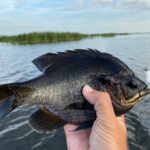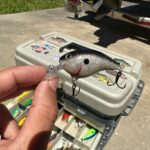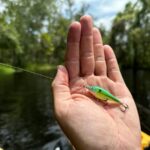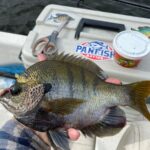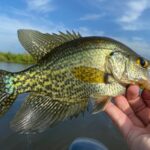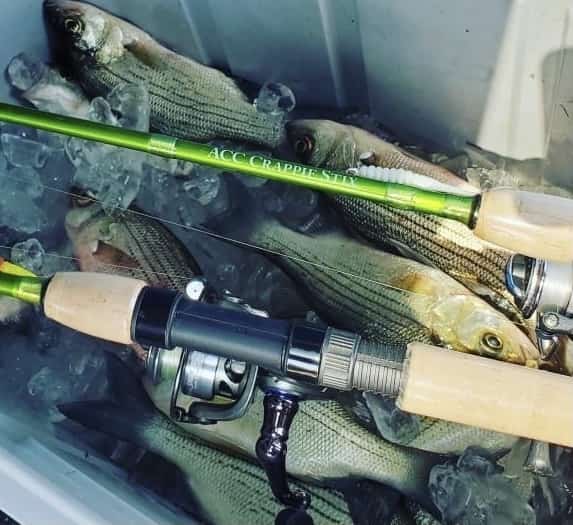
White Bass don’t make headlines like Largemouth, Smallmouth and other more prized gamefish…but what about the table quality? Is it really true they all taste like ‘mud’?
In this article, I’ll share with you my experience eating white bass …you might be surprised!
Table of Contents
Are White Bass Good to Eat?
White Bass are considered good to eat when they are eaten fresh and prepared properly. The meat is more firm during the colder months and most anglers remove the ‘mud vein’ or dark meat of the fillet before cooking. Soaking White Bass in milk or brine can reduce any fishy flavors.
Since they are a widely available and numerous fish, they should be a great source of food, especially since they are a member of the bass family…
White Bass are packed with healthy protein, minerals, and oils. While most types of bass have a reputation for being good eating, many fishermen will not eat white bass at all, claiming that it has a strong, fishy, or muddy flavor. While some like this flavor, many people don’t.
Another thing that puts some anglers off eating white bass is the appearance of the meat. White bass is somewhat of an oddity in the fish world…
Most species of fish have either white meat or red meat.
White bass have both!
This combination of meat types gives the meat a strange appearance.
There is no reason not to eat white bass, however. The fishy flavor can be easily dealt with if that is something that puts you off eating it.
For someone who only likes milder tasting fish, the preparation is the key to making white bass into a tasty meal instead of it just being a fish you catch and release.
If properly prepared, white bass is a good fish to eat. They are abundant and are a good source of both sport and food.
Is White Bass Fishy?
The best answer to this question is that some parts of the white bass are fishy. If you remove the fishy-tasting parts of the meat, then the rest of the fish won’t taste fishy at all.
It’s important to keep in mind that the water the fish is living in has a lot to do with how the fish tastes. A white bass that’s in muddy, dirty, or polluted water is going to taste a lot different than one that is swimming in clean water, eating clean, healthy food.
Where you choose to fish is going to have a lot to do with how your white bass tastes when you get it home.
The fishy part of the white bass is the red meat. Some people like this flavor, and for those people, preparation of the fish is easy. They can just cook it as is!
Those that prefer a milder flavor will need to remove the red meat and cook only the white meat. Proper handling of the fish at the time of catching it will also go a long way to reducing any strong flavors. Keep it on ice!
The white meat has a high oil content, so it is moist, firm, and flaky. The taste has been compared to walleye, perch, and striped bass.
How Do You Get The Fishy Taste Out Of White Bass?
The first step to not having fishy-tasting white bass starts when you are fishing. When you catch the bass, you should kill it and get it on ice as soon as possible.
Putting it in a live well isn’t a good idea. The fish may not survive in the well for very long and when they die, the warm temperature will start to degrade the taste of the meat quickly.
For the same reason, just tossing them in a creel or the bottom of the boat is a bad idea. If you don’t have ice with you, you can soak the fish when you get home to moderate the flavor, but it is better if you avoid letting it get warm in the first place.
Some people also believe that bleeding the fish immediately will help moderate the fishy flavor. This is done by slicing the gills and letting the blood drain out. When you get home, soaking the meat will also help remove any remaining blood.
While a key to a good-tasting white bass is keeping the meat cool, you should not freeze white bass meat long term as it really doesn’t tolerate freezing well. Instead, you want to cook your bass as soon as possible after catching it. Have a fish fry!
The final steps in getting the fishy taste out of the white bass are done when you are preparing and cleaning it.
How Do You Prepare And Clean White Bass?
More than many other fish, preparing and cleaning the white bass properly is essential if you don’t want fishy or muddy flavors.
The red meat is where the fishy flavor is, so what you want to accomplish when you clean the fish is to remove all the red meat, while keeping as much of the white meat as possible.
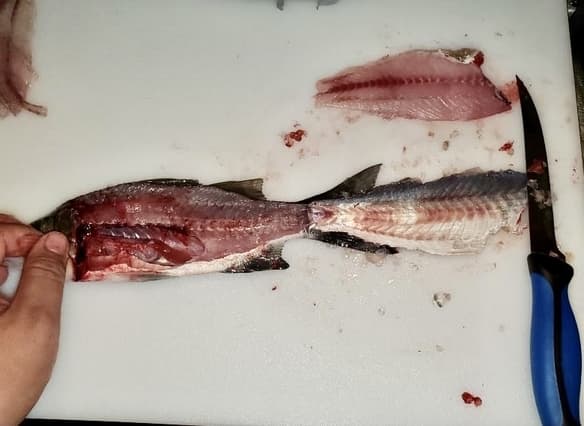
There is a very effective and simple way to do this. You set the fish down on your cleaning surface and get a sharp filleting knife. You start your filleting cut as normal, and slice from the head to the tail, going above the ribs.
When you get to the tail, you stop and fold the filet back, with the skin still attached to the tail.
At this point, cut like you are trying to remove the filet from the skin, but instead of going completely down to the skin, go down just far enough to still leave a thin layer of meat behind.
If you do this correctly, there will be a thin layer of red meat still attached to the skin when you are done.
Now you take the filet and identify the lateral line. This is very clearly visible on white bass. Cut just above the lateral line and take the lateral line and the little portion of meat below it and remove it from the filet and set it aside.
Rinse what is left, and what you will have is a nice, white filet that has the red meat removed.
Here is a great video demonstrating how to fillet a white bass!
Once you have done this, flip the fish over and do the same thing to the other side. The red meat that you are trying to avoid should now all be on the skin, the inside of the ribs, and in the lateral line chunks you have removed.
If you like pickled fish, the chunk you removed with the lateral line is very good for pickling.
Soaking the meat is the next step. Two hours seems to be best amount of time, as any longer changes the consistency of the meat. Soaking helps to get any remaining blood out, moderates any remaining muddy or fishy flavor, and may even add flavor depending on what you soak the fish in.
All kinds of liquids are used for soaking white bass filets. Some of the common ones are water, brine, ice water, milk, buttermilk, or fruit juices.
Some cooks even combine them, using a milk and lemon juice soak, for example. A soak in lemon or lime juice can add flavor to the meat and act as a type of seasoning.
You can try any and all of these and see which ones or which combinations are your favorites. Your imagination is really the limit here.
What is The Best Way To Cook White Bass?
If you aren’t worried about the fishy flavor and leave the red meat on, there is really no limit to what you can do. You can grill it or smoke it with or without the skin, you can fry it, bake it, or do anything you like.
If you are cooking the white meat filets, frying is the best way to go, either in a deep pan or a deep fryer. Like almost all types of fish, breading is a great way to cook it.
A mix of two-thirds crushed Italian bread crumbs with one-third cornmeal is a great option but there are an almost infinite number of different recipes.
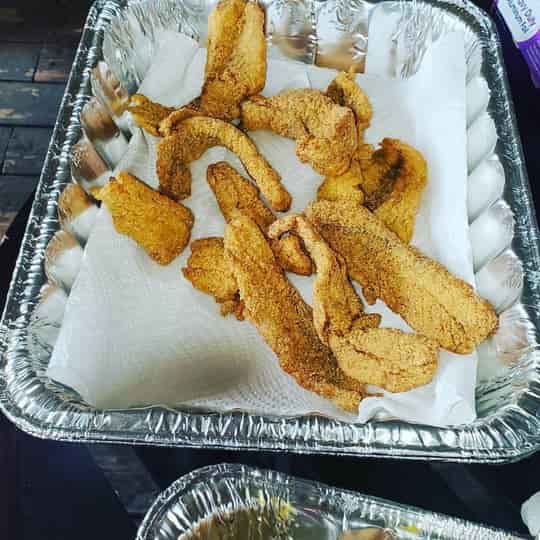
You remove the filets from whatever they have been soaking in, shake them in a bag with your breading of choice, and throw them in a frying pan or deep fryer.
You also don’t have to bread them if you don’t want to, or even fry them. Baked white bass is also quite good.
About White Bass Fishing
White bass, also known as silver bass, sand bass, or sandies, are a common fish that are native to the central part of the United States, including the Ohio and Mississippi drainage areas as well as parts of the Great Lakes.
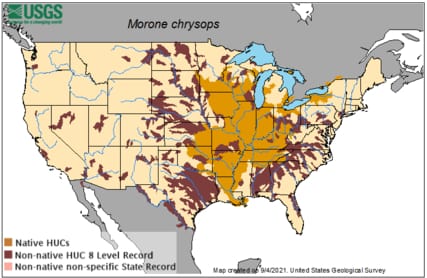
They have also been introduced throughout much of the rest of the country. White Bass are freshwater fish and shouldn’t be confused with any sea bass.
They are not related to largemouth and smallmouth bass, which are really members of the sunfish family, but are actually true bass, related to stripers, sea bass, and other members of the bass family.
White bass are a smaller fish, averaging about 12 inches in length, and weigh about one pound on average. They tend to travel in schools, so you can often catch several in a row which makes for some very exciting fishing!
See Also: Lake Livingston, Best White Bass Fishery In Texas?
They are a popular sport fish throughout their range, which is why they have been widely introduced outside of their native area.
I personally think that White bass are one of the best introductory species to young anglers and kids. They are relatively easy to catch, they do not require expensive tackle or gear, and they are often stocked by wildlife fishery agencies.
Conclusion
They may not be as popular as other species of bass, perch or walleye…but dont let that fool you. White bass are a TON of fun to catch, and can be great to eat if you know what your doing!
As with all fish, preparation and handling play a HUGE part in the taste and quality of your catch!
The next time your out fishing for white bass, save a few for the cooler and follow the tips in this article. I bet you will quickly learn why many anglers believe white bass is underrated.
Thanks for reading.
You May Also Like: Are Freshwater Drum Good To Eat? You May Be Surprised!
If you haven’t guessed yet, I love fishing and everything about it!
To learn more about why I started Panfish Nation, visit the About page and follow along on Social Media:


Download a copy of my FREE Lure Color Selection Chart & Knot Guide!
Stay up to date with fishing reports, tackle reviews, industry news, and much more! We respect your privacy, unsubscribe at any time.
Related Posts
- Crazy Facts About the World Record Crappie
- What Size Hooks for Smallmouth Bass? Quick Guide
- Large and in Charge-Mouth: 10 of the Best Bass Lures of All Time (And Where to Buy Them)
- Emperor of the Sun(fish): What You Need to Know About the World Record Bluegill
- The Seven Best Lures for Fall Bass Fishing
- Which Fishing Line is Best for Bass Fishing With A Spinning Reel?
- What Size Hooks for Panfish?
- Coppernose Bluegills: How They’re Different from Common Bluegill
- Best Crappie Lakes In North Carolina




